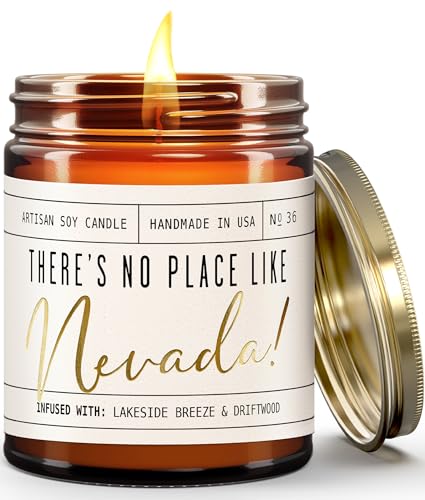You’re on the hunt for some fresh ideas to xeriscape your Nevada home’s yard, aren’t you? Well, you’re in luck! Creating a water-wise garden doesn’t mean you have to compromise on beauty. In fact, with the right plant selection and design techniques, your xeriscape can be just as vibrant and appealing as any traditional landscape.

Now let’s talk about the “why” before we jump into the “how”. Living in Nevada, you’re all too familiar with the harsh climate of hot summers and little rainfall. Xeriscaping is not just an option, it’s a smart choice for preserving precious water resources while maintaining a gorgeous outdoor space.
Don’t worry if you’re not sure where to start! We’ll give you a rundown of some inventive and sustainable ideas that’ll transform your barren desert yard into an enticing oasis. From choosing native plants that thrive in arid conditions to implementing clever irrigation strategies – we’ve got plenty of tips to get those green thumbs twitching!
Understanding Xeriscape: An Overview
You might be wondering, what’s this xeriscape all about? Well, it’s a type of landscaping that uses as little water as possible. Originating from the Greek word ‘xeros’, which means dry, this technique is perfect for areas like Nevada where water can be scarce.
Now you’re probably thinking, “But I don’t want my yard to look like a desert!” That’s the beauty of xeriscape – it doesn’t have to! With intelligent planning and design, you can have an attractive garden using native plants that thrive in your area’s natural environment. These hardy species have adapted to survive in conditions with minimal rainfall.
Let me throw some numbers at you. Traditional lawn watering consumes around 50-75% of a household’s water during the growing season. By switching to xeriscape principles, it’s estimated you could save up to 60% on your water usage!
| Comparison | Traditional Lawn Watering | Xeriscape |
|---|---|---|
| Water Consumption | 50-75% of household’s water | 20-30% of household’s water |
There are many different types of plants suitable for a xeriscaped garden. From flowering perennials like lavender and sagebrush, to ornamental grasses and succulents such as agave and yucca; there are options aplenty to create a vibrant oasis without guzzling gallons of precious H2O.
And let me assure you – adopting these principles doesn’t mean giving up on your outdoor living space! You can still include features such as patios, benches or even fire pits in your landscape design. The key here is balance – creating a beautiful outdoor area while being mindful about conserving resources.
So there you have it – an overview on xeriscaping! As we delve deeper into this topic, we’ll provide you with some practical tips and ideas to bring the principles of xeriscape into your own backyard. Stay tuned!
Nevada’s Climate and Xeriscape Gardening
It’s no secret that Nevada is known for its arid climate. In fact, it’s the driest state in the U.S.! Yep, you heard it right – with an average annual rainfall of only about 9.5 inches (compared to the national average of 30 inches), water conservation is a must here.
This is where xeriscape gardening comes into play. It’s not just a fancy term for desert landscaping; it’s a method specifically designed to reduce water use by up to 50%! Now, that’s impressive! With seven principles at its core – planning and design, soil improvement, appropriate plant selection, practical turf areas, efficient irrigation, use of mulches and proper maintenance – you’re set on your way to creating a garden that’s both beautiful and resource-friendly.
So what does this mean for your Nevada home? Well firstly you’ll want to focus on native plants. Yucca plants, sagebrushes or Joshua Trees are all great choices because they’ve adapted naturally to Nevada’s climate over thousands of years. They know how to handle those scorching summer temperatures!
But don’t worry if you’re after something with more color or variety – there are plenty of options out there! Consider flowering plants like Red Valerian or Desert Marigold which can add vibrant pops of color while still being drought-tolerant.
Remember though: even with xeriscaping your garden will need some upkeep! Mulching helps retain soil moisture and prevent erosion while regular pruning keeps those native plants healthy so they can keep looking their best through each dry season.
If you’re living in Nevada and love gardening but hate seeing your water bill rocket sky-high every month – try implementing these xeriscaping tips into your outdoor space.
Benefits of Nevada Xeriscape Ideas
Here’s a thought – imagine having a garden that thrives in Nevada’s arid climate, requires minimal watering, and still manages to be the envy of your neighbors. Sounds like a dream? Well, it’s not! It’s what you get with xeriscaping – a landscaping philosophy that embraces water conservation and native plants.
First off, let’s talk about savings. When you opt for a Nevada-friendly xeriscape design, you’re setting yourself up for some serious water bill cuts. Did you know that traditional gardens can guzzle up to 60% of your household water consumption? Yeah, shocking right? Now compare this with xeriscaped yards which use up to 75% less water. That’s quite the difference!
- Traditional Gardens: 60% of household water
- Xeriscaped Yards: Uses 25% of the water traditional gardens do
Next up is maintenance. Let’s face it; we’d all love to have more free time on our hands. With a xeriscape garden, there are fewer chores since these landscapes require less pruning and no mowing at all. You also don’t need to worry about fertilizing or applying pesticides because xeriscape plants are adapted to survive in local soil conditions.
Getting onboard the eco-friendly train is another benefit worth mentioning. By opting for native plants which are adapted to the local environment, you’re reducing your ecological footprint significantly.
« Yard Landscaping Ideas in Michigan: Your Guide to a Stunning Outdoor Space Wisconsin Xeriscape Ideas: Transform Your Yard into a Water-Saving Paradise »
Then there’s the beauty factor – xeriscaping doesn’t mean converting your yard into an arid desert scene (unless that’s what you’re going for!). There are numerous drought-tolerant but vibrant plant varieties available that’ll add color and liveliness to your property.
So go ahead! Embrace these benefits and transform your landscape into a stunning yet sustainable spot with Nevada Xeriscape ideas!
Top Plant Choices for Your Nevada Xeriscape
So, you’re ready to jump into xeriscaping your Nevada home. That’s fantastic! But where do you start? Well, the answer is simple: plants. Let’s take a look at some of the best plant choices that’ll not only survive but thrive in your new water-wise landscape.
Agave and yucca are two top picks when it comes to Nevada xeriscapes. These hardy desert-dwellers are built to withstand dry conditions, and they’ve got an aesthetic appeal that’ll give your yard a unique edge. With their dramatic shapes and sizes, agave and yucca can serve as striking focal points in your garden design.
- Agave: Known for its rosette shape and sharp leaf tips.
- Yucca: Famous for its sword-like leaves and towering flower spikes.
But let’s not stop there! There are other rock stars of the desert world too. Ever heard of Red Yucca or Desert Marigold? These beauties might be less known but they’re just as tough—and just as beautiful—as their more famous cousins:
- Red Yucca (Hesperaloe parviflora): Despite its name, this isn’t a true yucca. It’s actually closer to an agave! Its red flowers stand tall on long stalks above grass-like foliage.
- Desert Marigold (Baileya multiradiata): This perennial has woolly silver leaves and bright yellow flowers—perfect for adding lightness to your landscape!
Moving onto trees now; yes, trees can be part of a xeriscape too! Think about adding a native like the Joshua Tree or even consider an exotic such as the stunning Chitalpa:
- Joshua Tree (Yucca brevifolia): An iconic symbol of the Mojave Desert, this slow-growing tree has a unique and striking silhouette.
- Chitalpa (x Chitalpa tashkentensis): A hybrid tree that boasts beautiful clusters of trumpet-shaped flowers during summer.
And last but not least, don’t forget about those ground covers! Plants like Trailing Gazania and Creeping Thyme can provide color while keeping your soil in place:
- Trailing Gazania (Gazania rigens ‘Leucolaena’): Provides bright orange-yellow flowers against dark green leaves.
- Creeping Thyme (Thymus serpyllum): Not just for cooking, this thyme forms a dense mat of tiny, fragrant leaves with small pinkish-purple flowers.
So there you have it! With these plants in your xeriscaping arsenal, you’ll be well on your way to creating a stunning—and sustainable—Nevada landscape. Happy planting!
Irrigation Strategies for a Nevada Xeriscape Garden
Hey there, green thumb! Let’s dive into some key strategies on how to water your xeriscape garden in the Nevada terrain. It’s not as simple as turning on a hose, but don’t worry – we’ve got you covered.
First off, remember that watering deeply and infrequently is the name of the game. You’re aiming to encourage those plant roots to dig deeper into the ground for moisture. That’ll make ’em more resilient during those hot, dry spells (and let’s face it, Nevada has plenty of those). To help with this strategy:
- Use soaker hoses or drip irrigation systems instead of sprinklers: They deliver water directly to the root zone and minimize evaporation loss.
- Water early in the morning when temperatures are cooler: Less water will be lost due to evaporation.
Now, timing is everything when it comes to irrigation. Most native plants in a xeriscape garden actually prefer being a little thirsty over being drenched all the time. So one golden rule here? Don’t overwater! If you’re unsure about when exactly to water your plants, consider investing in an automatic irrigation system with soil moisture sensors – they take guesswork outta equation!
Lastly, mulching can really be your secret weapon here. Not only does it suppress weeds (yay!), but it also slows down evaporation from soil surface – meaning less watering needed from you.
Remember folks – smart watering doesn’t just save money on your utility bills; it’s also kinder on our precious environment. So why not give these strategies a try in your Nevada xeriscape garden? Happy gardening!
Designing Your Nevada Xeriscape Landscape: Tips and Tricks
Ah, the joy of xeriscaping! This unique landscaping method lets you create a vibrant garden that’s water-efficient. It’s an absolute win-win situation for you and the environment in arid regions like Nevada. So let’s dive into some tips and tricks to help bring your Nevada xeriscape landscape to life.
First thing’s first, know your soil. The composition of your ground plays a vital role in what plants will thrive best. In Nevada, you’re likely dealing with sandy or clay soil types which are perfect for drought-tolerant species.
Let’s talk about plant selection. You’ll want to choose native or drought-tolerant plants that require less water once established. Consider Agave parryi (Parry’s agave), Yucca baccata (Banana yucca), or Larrea tridentata (Creosote bush). These are just some examples of plants that can withstand Nevada’s heat without batting an eye!
Remember, arrangement matters too! Group plants together based on their watering needs – it helps conserve water by reducing runoff and evaporation loss. And don’t forget about mulch! Organic mulches like wood chips not only make your garden look tidy but also decrease evaporation from the soil surface.
Investing in efficient irrigation systems could be another game-changer for your xeriscape landscape. Drip irrigation directly targets the root zone making every drop count while cutting back on excess moisture that could lead to plant diseases.
Lastly, keep up with regular maintenance tasks like pruning and weeding to ensure your xeriscape stays healthy and beautiful year-round. Remember, a well-maintained xeriscape guarantees reduced water usage without compromising beauty!
There you have it – key elements for designing a stunning yet sustainable Nevada xeriscape landscape! Happy gardening!
Maintaining Your Nevada Xeriscaped Yard: A Simple Guide
You’ve made the wise decision to xeriscape your Nevada yard. Now what? Well, don’t fret because maintaining a xeriscaped yard is easier than you might think! It’s all about understanding the basics and getting into a routine.
First things first, let’s talk watering – a topic that might seem counter-intuitive in a xeriscape scenario. But even though your plants are drought-tolerant, they still need some hydration to survive those hot Nevada summers. A good rule of thumb is to water deeply but infrequently. This encourages roots to grow deeper into the soil where it’s cooler and moister. The best time for watering? That’d be early morning or late evening when evaporation rates are lower.
Next up on our list is weeding. Now, you didn’t think you were off the hook completely did you? Even in a xeriscape garden weeds can appear. However, if you’ve mulched properly weeds should be minimal and easy to pull out.
Thirdly, let’s consider pruning and trimming back your plants as needed for healthy growth and visual appeal. Remember not every plant needs regular pruning so do your research on each specific type in your yard!
And finally, keep an eye out for pests! While xeriscaped yards tend not have many pest problems due their natural resilience, it doesn’t mean they’re immune.
- Watering: Deeply but infrequently
- Weeding: Minimal with proper mulching
- Pruning/Trimming: As needed per each plant type
- Pest control: Low-risk but stay vigilant
Maintaining your xeriscaped yard is just that simple! With these tips up your sleeve, we’re confident that you’ll have no problem keeping your desert oasis thriving under the Nevada sun.
Conclusion: Embracing the Beauty of Nevada’s Natural Landscape
As we wrap up, remember xeriscaping isn’t about turning your back on lush, green landscapes. It’s about finding beauty in the rugged and resilient plants that call Nevada home. You’re not just creating an easy-to-maintain garden; you’re honoring the natural charm of your local environment.
Think about how striking a blooming cactus is against a desert sunset or how a sagebrush’s muted tones blend seamlessly with Nevada’s mountains. These are the scenes that take your breath away, and they can be part of your everyday lives right in your backyard.
Xeriscaping helps you become more water-wise too. With Nevada’s arid climate, it makes sense to embrace landscaping techniques that require less water:
- Using drought-resistant plants
- Incorporating rock gardens
- Utilizing mulch for moisture retention
Here’s an interesting nugget for you: By choosing to xeriscape, you could reduce outdoor water use by up to 60%! Now imagine if all Nevadans made this switch. We’d save billions of gallons each year!
Keeping our state beautiful while conserving its precious resources – now there’s something to strive for! So what do you say? Are you ready to explore the world of xeriscaping? Go ahead and dive right in, knowing every small step brings us closer to sustainable living.
















